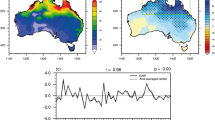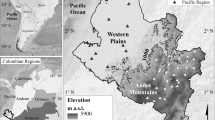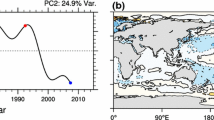Abstract
The 1958–2007 decline in March–August rainfall over southern Australia (south of 30°S) is very closely related to an increase in surface atmospheric pressure over Australia. Sea surface temperatures around northern Australia are strongly correlated with southern Australian rainfall but the recent warming of the ocean should have led to increased rainfall rather than the observed rainfall decline. The relationships between the rainfall and indices of several modes of the atmosphere/ocean system are investigated to determine a cause of the rainfall decline. Indices of the modes that only use data remote from the Australian region are used to avoid the possibility that a relationship between the mode and Australian rainfall is simply reflecting the behaviour of “local” portions of the index. Thus a climate mode index that incorporates Australian pressure would, of course, be related to southern Australian rainfall, even if the remote parts of the mode were unrelated to Australian rainfall. Unless the remote contributions to the mode index were also related to Australian rainfall it seems physically unrealistic to consider that the mode, per se, was affecting Australian rainfall (rather than simply reflecting the influence of the local pressure changes). The rainfall decline does not appear to be explainable by a change in the behaviour of the El Niño-Southern Oscillation (remote indices of this phenomenon do not exhibit a trend over this period) or the Indian Ocean Dipole (which is not strongly correlated with Australian rainfall on detrended data). The strong 1958–2007 trend in the southern annular mode (SAM) appears able to explain much of the rainfall decline since its year-to-year variations are correlated with year-to-year variations in southern Australian rainfall, and the sense of the correlation and the SAM trend would lead to a decline in rainfall (and an increase in pressure over Australia). The observed trend in SAM can reproduce over 70% of the observed rainfall trend. All these conclusions also apply to the rainfall declines in the southeast and southwest sub-regions.





Similar content being viewed by others
References
Allan RJ, Ansell TJ (2006) A new globally complete monthly historical mean sea level pressure data set (HadSLP2): 1850–2004. J Clim 19:5816–5842. doi:10.1175/JCLI3937.1
Archer CL, Caldeira K (2008) Historical trends in the jet streams. Geophys Res Lett 35:L08803. doi:10.1029/2008GL033614
Ashok K, Guan Z, Yamagata T (2003) Influence of the Indian Ocean dipole on the Australian winter rainfall. Geophys Res Lett 30. doi:10.1029/2003GL017926
Behera K, Yamagata T (2003) Influence of the Indian Ocean dipole on the southern oscillation. J Meteorol Soc Jpn 81:169–177. doi:10.2151/jmsj.81.169
Cai W, Cowan T (2006) SAM and regional rainfall in IPCC AR4 models: can anthropogenic forcing account for southwest Western Australian winter rainfall reduction? Geophys Res Lett 33. doi:10.1029/2006GL028037
England MH, Ummenhofer CC, Santosa A (2006) Interannual rainfall extremes over southwest Western Australia linked to Indian Ocean climate variability. J Clim 19:1948–1969. doi:10.1175/JCLI3700.1
Evans AD, Bennett JM, Ewenz CM (2008) South Australian rainfall variability and climate extremes. Clim Dyn. doi:10.1007/s00382-008-0461-z
Gallant AJE, Hennessy KJ, Risbey J (2007) Trends in rainfall indices for six Australian regions: 1910–2005. Aust Meteorol Mag 56:223–239
Hendon HH, Thompson DWJ, Wheeler MC (2007) Australian rainfall and surface temperature variations associated with the southern hemisphere annular mode. J Clim 20:2452–2467. doi:10.1175/JCLI4134.1
Jones D, Collins D, Nicholls N, Phan J, Della-Marta P (2004) A new tool for tracking Australia’s climate variability and change. Bull Aust Meteorol Oceanogr Soc 17:65–69
Kistler R, Kalnay E, Collins W, Saha S, White G, Woollen J, Chelliah M, Ebisuzaki W, Kanamitsu M, Kousky V, van den Dool H, Jenne R, Fiorino M (2001) The NCEP–NCAR 50-year reanalysis: monthly means CD-ROM and documentation. Bull Am Meteorol Soc 82:247–267. doi:10.1175/1520-0477(2001)082<0247:TNNYRM>2.3.CO;2
Larsen SH (2008) Australian winter anticyclonicity, 1850–2006. J Geophys Res 113. doi:10.1029/2007JD008873
Marshall GJ (2003) Trends in the southern annular mode from observations and reanalyses. J Clim 16:4134–4143. doi:10.1175/1520-0442(2003)016<4134:TITSAM>2.0.CO;2
McBride JL, Nicholls N (1983) Seasonal relationships between Australian rainfall and the southern oscillation. Mon Weather Rev 111:1998–2004. doi:10.1175/1520-0442(2003)016<4134:TITSAM>2.0.CO;210.1175/1520-0493(1983)111<1998:SRBARA>2.0.CO;2
Meneghini B, Simmonds I, Smith IN (2007) Association between Australian rainfall and the southern annular mode. Int J Climatol 27:109–121. doi:10.1002/joc.1370
Murphy BF, Timbal B (2008) A review of recent climate variability and climate change in southeastern Australia. Int J Climatol 28:859–879
Nicholls N (1989) Sea surface temperature and Australian winter rainfall. J Clim 2:965–973. doi:10.1175/1520-0442(1989)002<0965:SSTAAW>2.0.CO;2
Nicholls N (2006) Detecting and attributing Australian climate change: a review. Aust Meteorol Mag 55:199–211
Nicholls N (2008) Recent trends in the seasonal and temporal behaviour of the El Niño-Southern Oscillation. Geophys Res Lett 35:L19703. doi:10.1029/2008GL034499
Nicholls N, Lavery BM (1992) Australian rainfall trends during the twentieth century. Int J Climatol 12:153–163. doi:10.1002/joc.3370120204
Nicholls N, Lavery B, Frederiksen C, Drosdowsky W, Torok S (1996) Recent apparent changes in relationships between the El Niño-Southern Oscillation and Australian rainfall and temperature. Geophys Res Lett 23:3357–3360. doi:10.1029/96GL03166
Nicholls N, Drosdowsky W, Lavery B (1997) Australian rainfall variability and change. Weather 52:66–72
Oldenborgh GJ, van Burgers G (2005) Searching for decadal variations in ENSO precipitation teleconnections. Geophys Res Lett 32:15, L15701. doi:10.1029/2005GL023110
Raphael MN, Holland MM (2006) Twentieth century simulation of the southern hemisphere climate in coupled models. Part I: large scale circulation variability. Clim Dyn 26:217–228. doi:10.1007/s00382-005-0082-8
Seidel DJ, Fu Q, Randell WJ, Reichler TJ (2008) Widening of the tropical belt in a changing climate. Nat Geosci. doi:10.1038/ngeo.2007.38
Shi G, Ribbe J, Cai W, Cowan T (2008) An interpretation of Australian rainfall projections. Geophys Res Lett 35. doi:10.1029/2007/GL032436
Smith IN (2004) Trends in Australian rainfall—are they unusual? Aust Meteorol Mag 53:163–173
Taschetto AS, England MH (2008) An analysis of late twentieth century trends in Australian rainfall. Int J Climatol. doi:10.1002/joc.1736
Ummenhofer CC, Sen Gupta A, Pook MJ, England MH (2008) Anomalous rainfall over southwest Western Australia forced by Indian Ocean sea surface temperatures. J Clim 21:5113–5134
Williams AAJ, Stone RC (2008) An assessment of relationships between the Australian subtropical ridge, rainfall variability, and high-latitude circulation patterns. Int J Climatol. doi:10.1002/joc.1732
Acknowledgments
This research was supported by the Australian Research Council through Discovery Project DP0877417. Two anonymous reviewers provided very helpful and stimulating comments including the suggestion that trends in SAM might be causing the observed trends in some ENSO indices. The reviewer comments were also very helpful in clarifying the concept of local and remote causes of the rainfall trends and the relationship with indices relying on gradients in variables.
Author information
Authors and Affiliations
Corresponding author
Rights and permissions
About this article
Cite this article
Nicholls, N. Local and remote causes of the southern Australian autumn-winter rainfall decline, 1958–2007. Clim Dyn 34, 835–845 (2010). https://doi.org/10.1007/s00382-009-0527-6
Received:
Accepted:
Published:
Issue Date:
DOI: https://doi.org/10.1007/s00382-009-0527-6




